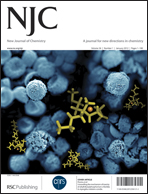We welcome you to NJC’s first issue of 2012. The new year gets off to a good start with the publication of high-quality, original and significant research works that display photosensitizers, dynamic combinatorial libraries, ab initio calculations, quantum dots, molecular magnets and much more.
 The outside front cover highlights a contribution from Cristina Silva Pereira et al. (Universidade Nova de Lisboa, Portugal and Queen’s University of Belfast, UK) that was aimed at defining the mechanism of toxicity of alkyltributylphosphonium chlorides [P4 4 4 n]Cl (n = 1, 3–8, 10, 12 or 14) in conidia of the filamentous fungus Aspergillus nidulans. Systematic elongation of one of the alkyl substituents resulted generally in higher toxicity, as defined by their inhibitory and lethal effects. In this study, fluorescence microscopy is proposed as a direct method for assessing the impact of ionic liquids on the plasma membrane integrity. Data were complemented by microscopic evaluation of the conidia cell wall and morphology. The higher toxicity of phosphonium ionic liquids carrying long alkyl substituents is most likely due to their strong interaction with the conidia cellular boundaries.
The outside front cover highlights a contribution from Cristina Silva Pereira et al. (Universidade Nova de Lisboa, Portugal and Queen’s University of Belfast, UK) that was aimed at defining the mechanism of toxicity of alkyltributylphosphonium chlorides [P4 4 4 n]Cl (n = 1, 3–8, 10, 12 or 14) in conidia of the filamentous fungus Aspergillus nidulans. Systematic elongation of one of the alkyl substituents resulted generally in higher toxicity, as defined by their inhibitory and lethal effects. In this study, fluorescence microscopy is proposed as a direct method for assessing the impact of ionic liquids on the plasma membrane integrity. Data were complemented by microscopic evaluation of the conidia cell wall and morphology. The higher toxicity of phosphonium ionic liquids carrying long alkyl substituents is most likely due to their strong interaction with the conidia cellular boundaries.
“Unravelling the mechanism of toxicity of alkyltributylphosphonium chlorides in Aspergillus nidulans conidia”, Marija Petkovic, Diego O. Hartmann, Gabriela Adamová, Kenneth R. Seddon, Luís Paulo N. Rebelo and Cristina Silva Pereira, New J. Chem., 2012, 36, 56-63, DOI: 10.1039/C1NJ20470J.
 NJC issue 1, 2012 inside front cover was produced by Dr Mike P. Coogan (Cardiff University, UK), Prof Lallan Mishra (Banaras Hindu University, India) and co-workers. In this research article, the authors describe the synthesis and study of a range of rhenium complexes appended through the axial pyridine ligand with groups known to direct cellular localisation. These complexes retain both their useful DNA binding and photophysical properties, while gaining the organelle specific-localisation desired. The imaging studies suggest that such complexes may be used as probes for oligonucleotides in specific cellular compartments (e.g. mitochondrial DNA). In addition, this study demonstrates that cellular localisation parameters are a vital consideration when designing probes to be applied in vivo.
NJC issue 1, 2012 inside front cover was produced by Dr Mike P. Coogan (Cardiff University, UK), Prof Lallan Mishra (Banaras Hindu University, India) and co-workers. In this research article, the authors describe the synthesis and study of a range of rhenium complexes appended through the axial pyridine ligand with groups known to direct cellular localisation. These complexes retain both their useful DNA binding and photophysical properties, while gaining the organelle specific-localisation desired. The imaging studies suggest that such complexes may be used as probes for oligonucleotides in specific cellular compartments (e.g. mitochondrial DNA). In addition, this study demonstrates that cellular localisation parameters are a vital consideration when designing probes to be applied in vivo.
“The importance of cellular localisation of probes: synthesis, photophysical properties, DNA interactions and cellular imaging properties of rhenium dppz complexes with known cellular localisation vectors”, Flora L. Thorp-Greenwood, Michael P. Coogan, Lallan Mishra, Niraj Kumari, Geeta Rai and Srikrishna Saripella, New J. Chem., 2012, 36, 64-72, DOI: 10.1039/C1NJ20662A.
You can access and read the whole issue available online at: NJC 2012, Issue 1. Leave us a comment and let us know what you think!
We wish you a happy new year 2012!










